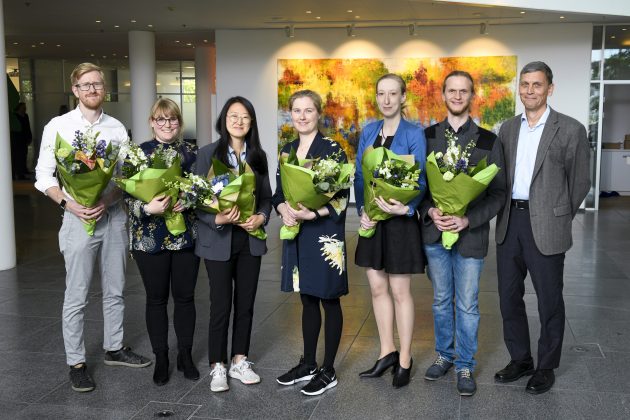Novo Nordisk Fonden har uddelt postdocstipendier til 16 talentfulde forskere fra Danmark og de øvrige nordiske lande. Forskerne blev fejret ved en festdag i fondens lokaler i Hellerup med deltagelse af bl.a. deres familier, venner og samarbejdspartnere.
Stipendiaterne fik under festarrangementet overrakt diplom og blomster og gav en kort præsentation af deres forskningsprojekter, der ligger inden for områderne lægevidenskab, biomedicin eller bioteknologi.
I alt er uddelt godt 48 mio. kr. til de 16 projekter, der gennemføres over de kommende 2-4 år.
Novo Nordisk Fondens forskningschef, Niels-Henrik von Holstein-Rathlou, var vært ved fejringen sammen med flere medlemmer af Novo Nordisk Fondens videnskabelige komiteer, som præsenterede og lykønskede stipendiemodtagerne.
”Jeg vil gerne lykønske stipendiaterne med deres bevillinger. De er udvalgt blandt mange kvalificerede ansøgere. Stipendierne giver modtagerne mulighed for at forske ved nogle af de bedste laboratorier i verden, og vi håber, at bevillingerne vil bidrage til at yderligere løfte modtagernes færdigheder og styrke deres selvstændige forskerkarrierer. Vi ser frem til at følge deres projekter i de kommende år,” siger Niels-Henrik von Holstein-Rathlou
Alle stipendiemodtagerne er fundet på baggrund af indsendte ansøgninger til Novo Nordisk Fonden og udvalgt af fondens videnskabelige komiteer, hvis medlemmer er forskere og eksperter inden for deres respektive områder.
Læs mere om de 16 stipendiemodtagere og deres forskningsprojekter nedenfor.
Postdocstipendier inden for Bioteknologi-baseret syntese og produktion:

Henrik Land, ph.d.
Beløb: 1.330.301 kr.
Varighed: 2 år
Værtsinstitution: Uppsala University, Department of Chemistry – Ångström Laboratory, Molecular Biomimetics, Sverige
Projekttitel: [FeFe]-Hydrogenase Biodiversity – Expanding the Toolbox of H2-Producing Biocatalysts
Resume: Hydrogenases are enzymes that catalyze the formation of molecular hydrogen (H2), a clean promising fuel for storage of energy from renewable but intermittent sources such as wind- and solar energy. Current H2-production methods are however not sustainable and this has hampered the implementation of H2 as a fuel in our society. Sustainable methods for H2-production are urgently needed and my research is focused on mining the available genome data for novel hydrogenases. The focus of this project is to explore several uncharacterized sub-classes of [FeFe]-hydrogenase and to evaluate their potential as future large-scale producers of H2.

Julie-Anne Gandier, ph.d.
Beløb: 2.276.817 kr.
Varighed: 3 år
Værtsinstitution: Aalto University, Finland
Projekttitel: Class I HFB proteins as a modular platform for cohesive “smart” nanostructured materials (HFBMat)
Resume: Wearable devices that sense and respond to our bodies and environment are a prominent feature of our current science fiction vision that are gradually becoming a reality. These smart materials offer a means of addressing societal concerns, such as providing independence to an aging population (e.g. wearable health monitoring). Our current visions of smart materials, however, focuses on electric signals to control programmed responses and so must integrate into their design potentially toxic conductive metals and coatings that can harmfully accumulate in ecosystems. The HFBMat project aims to develop protein-based building blocks that can support the transport of electric information through textiles. Rather than engineering the protein filaments to be conductive, the project uses a strategy inspired by nature to engineer the water at the surface of the proteins to carry ions in a concept similar to the way in which neurons carry nerve impulses. When successful, these biomolecules can be directly applied as components of stretchable electronic devices and textiles.

Che Lin Kim, ph.d.
Beløb: 1.586.425 kr.
Projektets varighed: 2 år
Værtsinstitution: Novo Nordisk Foundation Center for Biosustainability, DTU, Danmark.
Projekttitel: Engineering of CHO cell factories to improve ER capacity for difficult-to-express therapeutic proteins
Resume: The demand for therapeutic proteins to treat diseases continues to increase. Despite the advances in cell technology, many therapeutic proteins remain poorly expressed in Chinese hamster ovary (CHO) cell factories. The biosynthesis of these “difficult-to-express” proteins is complex and often exceed the capacity of the endoplasmic reticulum (ER) where is a primary site for protein synthesis. To understand and overcome the bottlenecks in protein production, a genome-wide approach is required. Using the state-of-the-art CRISPR/Cas9 technology, we will restore the expression of genes that are deficient or insufficient in CHO cells. Gain-of-function genetic screens will identify the novel genes regulating secretory pathway in CHO cells. Engineering of the identified genes will enhance the ER capacity and be valuable in the production of novel biopharmaceuticals.

Gonzalo Bidart, ph.d.
Beløb: 2.238.400 kr.
Varighed: 3 år
Værtsinstitution: Novo Nordisk Foundation Center for Biosustainability, DTU, Danmark
Projekttitel: Development of hyperstable glycosyltransferases using a novel microbial platform for in vivo high-throughput selection.
Resume: Industrial chemicals are currently produced mainly through environmentally challenging chemical synthesis routes. Enzymatic synthesis is more mild and efficient, but requires enzymes that can be stored and are stable in a variety of conditions to be economically tractable for the industry. We are working to develop a method to identify such “super-stable” enzymes in an extremely fast manner, using microbes that can live at high temperature as ‘selectors’. This method will make it so much quicker to find super stable enzymes, that it will start to become realistic to use them in industry. The enzymes we are working on are called glycosyltransferases, and they can attach a sugar molecule to many different chemicals, thereby controlling their stability, solubility, and other important properties. In the end, we want to use our super-fast method to find stable enzymes that can make flavoring agents, dyes, and pharmaceuticals.

Marie Sofie Møller, ph.d., cand.polyt.
Beløb: 1.599.433 kr.
Varighed: 2 år
Værtsinstitution: DTU, Danmark
Projekttitel: α-glucan debranching enzymes as tools for producing an array of valuable bioproducts
Resume: a-glucan debranching enzymes (GDEs) are industrial enzymes widely used for degrading starch e.g. in relation to biomass degradation. Some GDEs have been shown to have a by-activity, where they synthesise new products. However, the amino acids controlling the synthesis activity still remain to be identified in order to obtain optimised GDEs, which mainly do the synthesis reaction, by engineering. The new products will be starch which is harder for humans to digest, hence functioning as functional food with health-promoting effects. Another goal will be synthesis of products, where functional groups are coupled to starch or smaller fragments of starch, hence making it possible to incorporate them in bio-materials.

Norman Adlung, Dr.
Beløb: 1.519.355 kr.
Varighed: 2 år
Værtsinstitution: Aalto University, Finland
Projekttitel: Genomic Engineering of Methanosarcina acetivorans to convert methane to electricity
Resume: By genomic engineering of the methane producing organism Methanosarcina acetivorans, I aim to reverse its metabolism to perform Anaerobic Oxidation of Methane (AOM) with the release of single electrons (electricity). This idea is inspired by nature where the similar reaction evolved in ANaerobic MEthane-oxidizing archaea (ANME). AOM is a relevant process in the global Carbon cycle and has a large technical potential. It might be uses to convert methane to electricity or other valuable products. Unfortunately, AOM-performing ANME are uncultivable deep-sea organisms with an extraordinary high doubling time (several months), which prevents their technical use and detailed characterization. By contrast, M. acetivorans is closely related to ANME, cultivable, tractable to genetic tools and naturally performs anaerobe methanogenesis, the backward reaction of AOM. Engineering an AOM-performing M. acetivorans strain will increase our understanding of AOM and, in a long term, might help to satisfy the world’s growing need for “clean” energy.

Zarah Forsberg, Dr.
Beløb: 2.346.169 kr.
Varighed: 3 år
Værtsinstitution: Norwegian University of Life Sciences (NMBU), Norge
Projekttitel: Modularity as a tool to harness the power of redox enzyme systems in polysaccharide conversion
Resume: Efficient enzymatic degradation of non-edible plant biomass (“lignocellulose”) to fermentable sugars that can be converted to fuels, chemicals or materials is a key step in the transition towards a sustainable bio-economy. Degradation of such biomass requires large amounts of enzymes, representing a major cost, and thus, further improvements in enzyme technology are of interest. In this project, we will study how we can optimally use the recently discovered Lytic Polysaccharide MonoOxygenases (LPMOs) in biomass processing. In particular, we will study the potential of LPMO variants that consist of multiple modules, for example an additional substrate-binding module. The project will also address the interplay between LPMOs and other redox enzymes that are not yet used industrially, but that are gaining increasing interest. The ultimate goal is to develop better enzymes and optimized bioprocesses for efficient processing of lignocellulosic biomass.
Postdocstipendier til forskning i udlandet – Biovidenskab og basal biomedicin

Cagla Sahin, ph.d.
Beløb: 3.640.073 kr.
Varighed: 4 år
Værtsinstitution: Karolinska Institutet, Sverige og Københavns Univetsitet, Danmark
Projekttitel: The superstructural biology of RNA-binding amyloid-like proteins in neurodegeneration and memory formation
Resume: Inside cells, proteins are busy fulfilling specific tasks by binding to other molecules, and wrong interactions can lead to disease. When the brain stores information, certain proteins self-assemble together with other molecules into large scaffolds that bind copies of different genes. These scaffolds resemble protein assemblies called “amyloid” that are a hallmark of diseases such as Alzheimer’s. Despite being similar, one protein family forms functional, “good” structures, and the other pathogenic, “bad” ones. Here, we use mass spectrometry, a technique that allows us to weigh proteins, and nuclear magnetic resonance spectroscopy that gives structural information, to follow their interactions to understand what makes protein assemblies in the brain bad or good. Which parts of the proteins bind together? Can we interfere with these interactions? Answering these questions will help us to better understand the relationship between normal brain function and disease.

Melek Cemre Manav, ph.d.
Beløb: 3.998.207 kr.
Varighed: 4 år
Værtsinstitution: Medical Research Council Laboratory of Molecular Biology, Storbritannien, og Aarhus Universitet, Danmark.
Projekttitel: Cryo-electron microscopy and functional studies of targeted deadenylation complex: Insights into mRNA deadenylation at the molecular level
Resume: mRNA turnover is a fundamental aspect of gene regulation. In the nucleus, eukaryotic mRNAs are polyadenylated at the 3′-end [poly(A) tail] and the poly(A) tail is crucial for gene regulation. In the cytoplasm, mRNAs are de-adenylated, where the length of the poly(A) tail is gradually shortened. After the poly(A) tail is removed, the mRNA is degraded, which makes deadenylation a critical step in determining the lifetime of mRNAs. The tail is protected by Pab1 and shortened by Ccr4-Not. This process is further regulated by RNA-binding protein tristetraprolin, promoting targeted deadenylation. Understanding how these proteins work in such a large assembly will reveal in greater detail how mRNAs are regulated through their 3′-end. This will lay the groundwork for treatment of many diseases such as heart failures as well as for therapeutic processes like gene silencing.

Peter Thorlund Haahr, ph.d.
Beløb: 3.986.925 kr.
Varighed: 4 år
Værtsinstitution: Netherlands Cancer Institute, Holland, og Københavns Universitet, Danmark
Projekttitel: Charting the genetic landscape of replication stress using haploid genetics
Resume: Cancer, a disease characterized by the uncontrolled division of malignant cells, is a leading cause of death world-wide. In order to proliferate and divide, cancer cells need to copy their genetic material via a delicate process called DNA replication. Rapid cancer cell growth is associated with stressed DNA replication, a condition that potentially can lead to ‘catastrophic’ cell death. However, cancer cells employ multiple strategies, of which many are still unknown, to protect themselves from ‘replication catastrophe’ and cell death. This is often described as an Achilles heel of cancer, as targeting these protective mechanisms could selectively unleash cancer cell death and provide a powerful treatment strategy in the clinic. My project aims to unravel the mechanisms that protect cancer cells from replication stress by using advanced cell-based screening technologies. Hence, the findings of this project may pave the way for future development of new cancer therapies.

William Joyce, ph.d.
Beløb: 3.924.561 kr.
Varighed: 4 år
Værtsinstitution: University of Ottawa and University of Guelph, Canada, og Aarhus Universitet, Danmark
Projekttitel: The evolution of adrenergic regulation of heart performance: a comparative perspective
Resume: Cardiac contraction is triggered when calcium activates protein motors (myofilaments) in heart muscle. The calcium sensitivity of myofilaments is thus a crucial determinant of heart performance, and altered calcium sensitivity is a hallmark of heart failure. There is a dearth of information on how myofilaments are regulated in animals, in which the proteins exhibit conspicuous differences that have accrued during evolution, but I propose a deeper understanding will reveal secrets with therapeutic potential. In my project I will compare how the proteins that change myofilament calcium sensitivity are regulated by adrenaline in diverse animals: fish, reptiles, birds and mammals. This will elucidate the molecular pathways that may be targeted to help treat heart disease.
Postdocstipendier til forskning i udlandet – Endokrinologi og metabolisme

Brendan M. Gabriel, ph.d.
Beløb: 3.997.827 kr.
Varighed: 4 år
Værtsinstitution: University of Edinburgh, Skotland, and Karolinska Institutet, Sverige
Projekttitel: Identifying novel skeletal muscle targets for obesity treatment and prevention.
Resume: This project is a collaboration between the University of Edinburgh (UoE) and the Karolinska Institute (KI). It will utilise data from a group of mice that have been bred to be either lean or obese to identify new genetic targets for treating obesity. These mice have previously been studied at UoE to identify new targets in their fat tissue, but we will now probe their muscle tissue. Muscle is important in obesity as it stores a majority of sugar after meals, and utilises fat. We plan to manipulate these genetic targets in cells and mouse muscle to further investigate them. KI’s excellent resources to test these genetic targets in a clinical setting, and understand their relevance to human biology strengthen this collaboration. For example, muscle samples and cells from individuals with obesity, can be used to test the role these genes play in human biology. Lastly, we have the capacity to assess various treatments of obesity and their ability to modify the regulation of these genes.

Kaja Plucinska, ph.d.
Beløb: 3.985.865 kr.
Varighed: 4 år
Værtsinstitution: Rockefeller University, USA, og Novo Nordisk Foundation Center for Basic Metabolic Research, Københavns Univertsitet, Danmark
Projekttitel: Brown and beige fat secretome – discovery and characterization of novel endocrine factors regulating insulin sensitivity and energy balance in vivo
Resume: Obesity, a major cause of Type 2 Diabetes (T2D), is linked with many health complications. Fat tissue plays a fundamental role in T2D development, as its functions to store excess calories (white fat) or burn them during ‘thermogenesis’ (brown fat) become impaired. These events give rise to ‘insulin resistance’, a condition of poor sugar clearance from blood. Recent data suggest that brown fat may produce potent circulating hormones, which regulate insulin sensitivity, but the identity of these hormones remains unknown. We recently discovered a number of such circulating factors and propose to identify their molecular mechanisms and sites of action.

Maximilian Kleinert, ph.d.
Beløb: 3.900.000 kr.
Varighed: 4 år
Værtsinstitution: Helmholtz Zentrum München, Tyskland, og Københavns Universitet, Danmark
Projekttitel: Novel Mechanisms in Skeletal Muscle Metabolism Pertaining to Health
Resume: Given its size and ability to store large amounts of sugar (glucose), skeletal muscle is a key organ for maintaining normal blood glucose levels in humans. Conversely, insulin resistance of muscle, which describes a defect in the glucose storage ability of muscle following insulin stimulation, is a major risk factor for the development of type 2 diabetes (T2D). Despite this well-established knowledge, skeletal muscle has thus far been an underappreciated organ in terms of opportunity to prevent or treat T2D. Therefore, this application focuses on novel exercise- and metabolism-related signaling pathways to identify innovative therapeutic strategies to treat insulin resistance of muscle and thus prevent T2D.

Panu K. Luukkonen, M.D., D.Med.Sci.
Beløb: 4.000.000 kr.
Varighed: 4 år
Værtsinstitution: Yale University School of Medicine, New Haven, USA, og Minerva Foundation Institute for Medical Research, Helsinki, Finland
Projekttitel: Heterogeneity of Non-Alcoholic Fatty Liver Disease in Humans
Resume: Non-alcoholic fatty liver disease (NAFLD) is the most common chronic liver disease, affecting up to 1 in 4 of the Western population, and predisposes to liver cirrhosis and cancer. Treatment options for NAFLD are scarce, of which weight loss is amongst the most effective. There are two common subtypes of NAFLD; one related to overweight and one to genetics. For unknown reason, the former but not the latter is associated with insulin resistance that precedes type 2 diabetes and heart disease. In Project 1, we will comprehensively assess the effect of weight loss on liver fat and carbohydrate metabolism in the two subtypes of NAFLD in humans using a new state-of-the-art method by analyzing blood samples taken during infusion of safe, non-radiating tracers. In animals, insulin resistance is mediated by distinct class of lipids, diacylglycerols (DAGs). In Project 2, we study the effect and underlying mechanisms of DAGs on insulin resistance in human liver samples.

Sarah McGarrity, ph.d.
Beløb: 3.992.447 kr.
Varighed: 4 år
Værtsinstitution: Harvard University, USA, og University of Iceland, Island
Projekttitel: The effect of the endothelial glycoclayx on superoxide dismutase, glutathione peroxidase and nitric oxide synthase activities during stimulation
Resume: Endothelial cells (EC) line blood vessels and are important to control blood pressure and clotting. ECs are covered by a proteoglycan rich layer, the endothelial glycocalyx (EGL), important to this control. The EGL houses enzymes that produce nitric oxide (which controls blood pressure) and remove damaging reactive oxygen species (ROS). Hyperglycaemia, inflammation, blood flow and adrenal hyperactivity affect the EGL and are known to contribute to cardiovascular disease development. This fellowship will try to better understand the mechanisms that link changes in the make-up of the EGL, after interventions in glucose level, adrenaline and blood flow, with the activity of EGL housed enzymes and therefore to better understand vascular health and disease.
Yderligere information
Christian Mostrup Scheel, presseansvarlig, tlf.: 3067 4805, [email protected]








